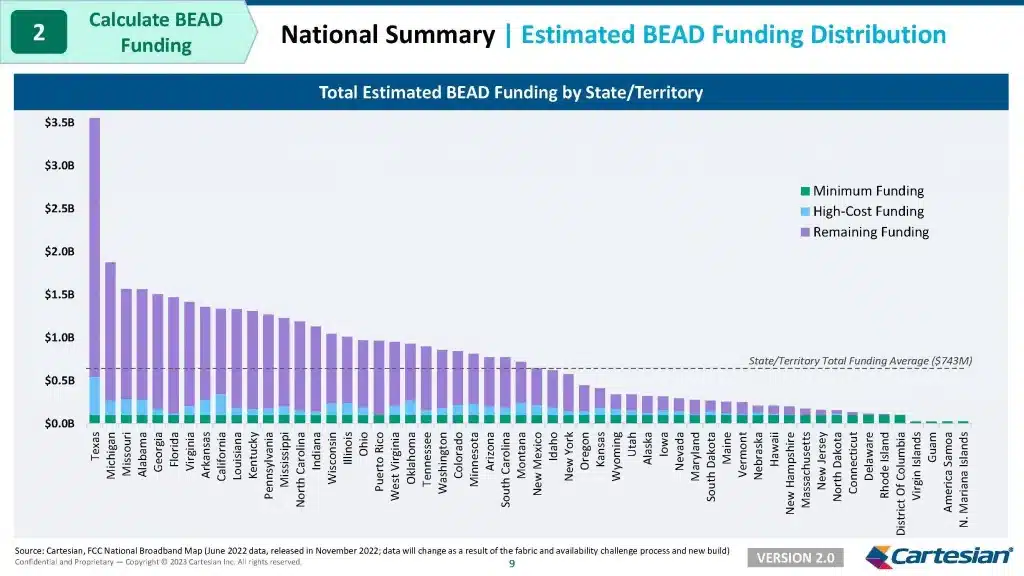Ten southern states are each expected to receive over $1 billion in rural broadband funding through the Broadband Equity Access and Deployment (BEAD) program, according to an estimate released earlier this year from Cartesian for provider association ACA Connects.
In comparison, only five other states are expected to receive more than $1 billion.
Final allocations are due from NTIA by June 30, but Cartesian used the same methodology that NTIA plans to use in making allocations but using earlier location and availability data.
As we previously reported, Cartesian expects Texas to receive about $3.6 billion in BEAD funding. That’s almost twice as much as any other state.
Other southern states expected to receive more than $1 billion are Alabama, Florida, Georgia, Arkansas, Virginia, Kentucky, Louisiana, Mississippi and North Carolina.
The total funding expected to flow to those states comprises about 37-38% of the total $42.5 billion that is expected to be awarded in the program.
Non-southern states that are also expected to get more than $1 billion are Michigan, Missouri, California, Pennsylvania and Indiana.

Telecompetitor asked Cartesian why southern states were expected to receive so much BEAD funding. Managing Director Samuel Kornstein responded as follows. (Please note that an “entity” in BEAD jargon is a state or territory.):
We estimated each Entity’s BEAD Funding Allocation using the November 2022 FCC Broadband Map Location data and the funding formula specified by the BEAD statute: the sum of Minimum Allocation, High-Cost Allocation, and Remaining Funds Allocation.
The Minimum Allocation is a fixed $100M for States or $25M for Territories. The High-Cost Allocation fund, which is $4.2B in total, is distributed to each Entity in proportion to their share of locations that are high-cost unserved locations.
To estimate the share of high-cost unserved locations for each Entity, we used Cartesian’s proprietary cost model to determine the census tracts that have the top 10% of costs in the nation to deploy fiber and aggregated the number of unserved locations in these census tracts by State and Territory. Finally, the Remaining Funds Allocation, which is $33B in total, is distributed in proportion to each Entity’s share of the nation’s unserved locations in its own State/Territory.
Given the structure of the BEAD Funding formula, many States/Territories may receive a higher amount of funding due to a higher share of unserved locations. For example, we estimate Louisiana to receive $1.3B total funds, since its share of unserved locations is 3.6%, compared to the national average of 2%. Similarly, Georgia and Florida are expected to receive $1.5B total funds each since both states have a 4% share of unserved locations.
We’d also like to call out that the FCC Broadband Maps Data will be refined to reflect the availability challenge process and new builds. Consequently, when the BEAD Allocations are announced later this year, we expect the State/Territory funding allocations to differ slightly from our estimates, as the allocations will be based on newer and updated FCC Broadband Maps data.
Not all states are content with the amount of funding they are expected to receive. A bill introduced by senators from Nevada and South Dakota would require the FCC to make certain updates to the broadband map prior to the allocation of BEAD funding, thereby delaying those allocations.
Unsurprisingly both states are expected to get less than $300 million, putting them in 37th and 39th place among the 50 states, according to the Cartesian estimates.
It is unclear how much support the proposed legislation is likely to receive, however, considering that some states do not want the allocations to be delayed, arguing that doing so would not materially impact the results but would delay deployments.



